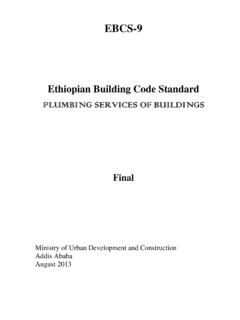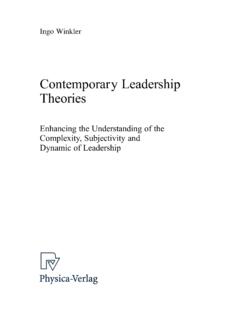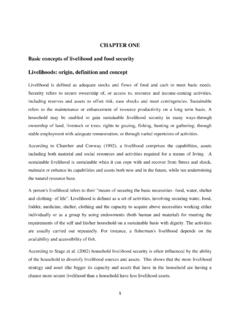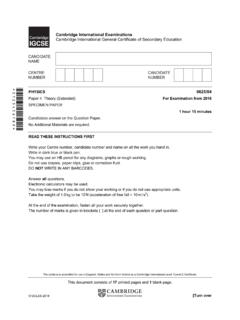Transcription of Chapter 2 Productivity of Construction Equipments ...
1 Chapter 2 Page 1 Chapter 2 Productivity of Construction Equipments : Earthwork Equipments Definition: - Productivity in Construction is defined as a unit output per hour. An accurate prediction of the Productivity of Construction equipment is critical for Construction management. 1. Construction Equipment Productivity Determination Estimating actual Productivity is an essential element in estimating the time and cost required to complete Construction operations. Terminologies Peak Productivity (Qp): is the ideal or theoretical Productivity governed by design limitations only. ` Where: Qp = Peak Productivity V = Volume carried/ bucket capacity fs = Bank Volume/loose volume ff = Bucket fill factor Actual Productivity : Productivity of equipment after taking care of effective working hours and job management factor on the peak Productivity . Where: Qa = Actual Productivity Qp = Peak Productivity fw = Factor to take care of effective working hours fj= Factors to take care of the management conditions The computation of the actual production of Construction equipment is complex.
2 But through idealization, approximation and in general simplification, one can arrive at an optimum result. f xf xQfspV jwpf xf xQaQ Chapter 2 Page 2 of Construction equipment Equipment can be broadly classified into two based on their Productivity concepts: these are: - cyclic operating and continuously operating Equipments . Cyclic operating equipment: These are machines which are intentionally or unintentionally influenced by their operators. The actual Productivity can be computed from: Where: Qa = Actual Productivity (Bm3/hr) Vn = Volume per cycle (Bm3) = Efficiency of the equipment no = number of cycle /Unit Time (usually Time in hours), if To is theoretical cycle time Continuously operating equipment: These are machines that continuously operate, like pumps, conveyor belts, etc. For these kinds of machines the actual Productivity can be estimated from the following formula. Where: Qa = Actual Productivity (Bm3/hr) Vn = Volume per bucket a = Number of buckets = Efficiency of the equipment no = number of cycle /Unit Time (usually Time in hours) In this course only cyclic Construction equipment Productivity estimation is considered.
3 OT 60no x 60 xon x a xnVaQ xon xnVQa Chapter 2 Page 3 2. Productivity Of Shovel Family And Excavators Qa- Shovel family is dependent on the actual volume per cycle and the cycle time. Vn Volume per bucket. Plate line capacityis the bucket volume contained within the bucket when following the outline of the bucket sides. Struck capacityis the bucket capacity when the load is struck off flush with the bucket sides or volume actually enclosed by the bucket with no allowance for the bucket teeth. Water line capacityassumes a level of material flush with the lowest edge of the bucket ( , the material level corresponds to the water level that would result if the bucket were filled with water). Heaped volumeis the maximum volume that can be placed in the bucket withoutspillage based on a specified angle of repose for the material in the bucket. The angle of repose depends on the type of material. Figure Struck and Heaped Bucket Capacity (Caterpillar Inc.)
4 Commonly - Bucket ratings for the cable shovel, dragline, and cable backhoe are based onstruckvolume. Thus it is often assumed that the heaping of the buckets will compensate for the swell of the soil. That is, a 5 m3 bucket would be assumed to actually hold 5 Bank m3 of material. Chapter 2 Page 4 A better estimate of the volume of material in one bucket load will be obtained if the nominal bucket volume is multiplied by a bucket fill factor(f)or bucket efficiency factor( ). If desired, the bucket load may be converted to bank volume by multiplying its loose volume by the soil s load factor. Example A front shovel is excavating a common earth. Estimate the practical capacity of the bucket inbank measure if the load factor of the material is Solution From table 2 the bucket fill factor = taking the lower value. Bucket load = Bucket Volume x x fL = x x = bcy Chapter 2 Page 5 Cycle Time (Tc) In calculating the time required for a Construction equipment to make one complete cycle, it is customary to break the cycle down into fixed and variable components.
5 Tc = Tf + Tv Where:- TV=Variable Cycle Time - Variable time represents those components of cycle time related with travel time. Itis the time required to excavate and travel to load and travel to return to its original position after loading. TF = Fixed Cycle Time - Fixed time represents those components of cycle time other than travel time. It represents the time required to maneuver, change gears, start loading, and dump. Number of cycle (no) =Unit Time/Tc = 60/Tc , Where Tc cycle Time in minutes Productivity of Face Shovel (Power Shovel) A face shovels are used predominantly for hard digging above track level and for loading hauling units. Shovels are capable of developing high breakout force with their buckets, but the material being excavated should be such that it will stand a vertical bank. The size of a shovel is indicated by the size of its bucket expressed in cubic meter. Estimation of shovel production. The production capacity or output of a shovel is expressed in cubic meter per hour.
6 There are four elements in the production cycle of a shovel:-Loading bucket, swing with load, dump load and return swing with empty bucket. Chapter 2 Page 6 The output varies for various type of materials to be digged. The following are the main factors which affect the output of face shovel:- Site Condition Height or Depth of cut Type of material Angle of swing Capacity of hauling unit and continuity of work Mechanical condition of shovel Efficiency of the operator Relative positions of the shovel and hauling unit Type of machine such as crawler or wheeled A. Face shovel Productivity factors I. Optimum Height of Cut:-is the height that will result in a full dipper (bucket) in one pass. If the height of cut is shallow, the bucket does not fill up in one pass. The operator has a choice of making more than one passes or apply more pressure and this process increases the cycle time and eventually reduce its production. If the height of cut is higher than the optimum, then the bucket will be filled before pass completion.
7 In this case the operator has a choice of applying less pressure on the bucket or digs upper part first then, clean bottom part later. Percentage of optimum height (POH):Actual heightoptimum height of cut 100 Optimum height = 30%-50%) of maximum digging height for the shovel II. Angle of swing: The angle of swing of a shovel is the horizontal angle, expressed in degrees, between the position of the bucket when it is excavating and the position where it discharges the load. The total cycle time includes digging, swing to the dumping position, dumping and Chapter 2 Page 7 returning to the digging position. Increasing the swing angle will increase the cycle time and vise versa. The probable hourly production of shovel family can calculated using the following formula. Generally the output of the face shovel can be estimated by the following formula. Hourly production (m3/hr) = q x (3600/C) x Efficiency Where: q = production in m3 per cycle = Heaped capacity x Swell factor x Bucket factor.
8 Table Chapter 2 Page 8 Manufacturer of the equipment used to provide a graph b/n bucket size Vs this gives production in ideal conditions, the figures thus obtained should be scaled down to expected production by using efficiency factor and bucket fill factor. Table bucket fill factor Bucket Fill Factor Sand, gravel, common earth 90% Well blasted rock 70% Poorly blasted rock 50% The above figures are for crawler type of tractor shovel, however for wheel shovels, bucket factor is about 10% lesser than those mentioned above. A hydraulic front shovel excavating common earth has a heaped capacity of cyd. Its maximum digging height is given by the manufacturer as 7m. the average angle of swing 120o. the average height of cut is What is the hourly rate of production in m3bm/hr, if the shovels cycle time is 19 sec? Take the shovel s optimum height of cut as equal to 30% of its maximum digging height.
9 Assume the job efficiency and bucket load factor to be 50min/hr and respectively. Solution Bucket capacity in m3 = * = loose measure Earth volume conversion factor from loose to bank = Cycle time Tc= 19sec Optimum height of cut = 7* = Chapter 2 Page 9 %age of optimum height = 100 =140% Depth- swing factor (from table ) f1 = , bucket fill factor = from table Job efficiency = 50min/60min = Rate of hourly production P = (3600* Q *f * k * f1 * )/Tc = (3600 * * * * * ) / 19sec = m3bm/hr. Productivity of Dragline A dragline excavator is especially useful when there is need for extended reach in excavating or when material must be excavated from under water. Drag bucket and clamshells are both attachments hung from a lattice boom crane. The output of a dragline is best obtained from field measurement. But it can also be estimated by Productivity determination formula. Output or performance of dragline depends on the following factors: Nature of the soil.
10 Depth of cut. Angle of swing. Length of boom Method of disposal Capacity of hauling units, if employed. Mechanical condition of the dragline. Efficiency and skill of the operator. Management conditions. Size and type of bucket. Working cycle Data are taken from Liebher s Technical Hand Book Earth moving Product line . Drag Line Production = Bucket capacity (m3) x Number of cycle (C) x f Chapter 2 Page 10 Where, C = Theoretical Cycles/hr, estimated number of cycle for dragline = 120 Cycles/hr f = Correcting factor f = f1 x f2 x f3 x f4 x f5 x f6 x f7 The correction factors are all factors affecting the Productivity of the dragline. f1 - Fill factor Class Fill factor 1 Sand or fine gravel to a) Dry to b) Damp to c) Wet 2 Clay to a) Sandy clay, dry to b) Cohesive, dry to c) Very cohesive, hard 3 Earth with sand or gravel, dry to 4 Top Soil to a) Sandy clay to b) Clay damp 5 Clay with sand or gravel, damp to 6 Slatelike rock, gravel to 7 Gravel with clay, hard to 8 Clay with large size gravel, damp to f2 Digging factor Boom Length (m) 12 18 24 30 Digging factor,f2 Chapter 2 Page 11 f3 Hoist factor Boom Length (m) 12 18 24 30 Hoist factor,f3 f4 Swing factor (Simultaneous swing and hoist) Angle of Swing (deg)
















